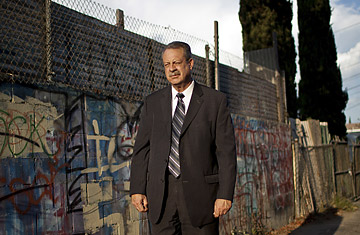
(6 of 7)
Spriggs and Los Angeles district attorney Steve Cooley made a strong case to Brown that protocols to protect privacy could be made airtight by not revealing any information about familial-search matches to law enforcement until a search of public records had located a relative who was a likely suspect. Spriggs also pledged that familial search would be used only as a last resort in violent cases of murder or rape and where all other investigative avenues had been exhausted. And they told Brown they had the perfect test case: the Grim Sleeper.
Match Point
Franklin retired from the sanitation department in February 1989, at age 36, on disability for a shoulder injury. From 1989 to 2003, he was arrested nine times, convicted twice and sent to jail once. But California did not take DNA samples from nonviolent convicted felons until 2004, so his DNA was never entered into the state's genetic database. He kept up his nighttime cruising habits, according to his neighbors--driving up and down Western, talking to the women he met along the streets. He liked to take pictures of some of the women, often with their breasts exposed. Sometimes he showed the pictures to Cole, the neighbor across the street. "All he talked about was women," says Cole.
In 2008 a billboard offering a $500,000 police reward for information on the Grim Sleeper (and bearing a crude police artist's rendering of the killer) went up at 79th and Western, two blocks from Franklin's house. A neighbor later told the police she was riding with him in his car one day and said she would love to get that reward. Franklin told her, "They'll never catch that guy. The picture probably doesn't even look like him."
From Sacramento, Brown gave his approval to try a familial DNA search. Spriggs was hopeful; California has the fourth largest DNA database in the world, after the U.S., the U.K. and China. Even though the Grim Sleeper wasn't among the 1.8 million DNA samples on file in the state's main laboratory in Richmond, there was a chance that one of his relatives was.
After six months--at a cost of $500,000--of writing DNA-scanning software and setting up protocols prohibiting investigators from communicating with or surveilling a putative family member with a close match to the crime-scene DNA, Spriggs and her team ran the search in Richmond in October 2008. They got nothing. "Goose eggs," says Kilcoyne, remembering the disappointment. More than a year passed before Spriggs tried again, hoping some samples newly added to the DNA database would generate a match. On June 22, 2010, they got a hit: a young man named Christopher Franklin, arrested and later convicted on a November 2008 firearms charge. He was too young to have carried out the '80s murders, but public records revealed that his father Lonnie was the right age and had not been in prison or out of the country at the time of any of the murders. And Lonnie lived at 1728 81st Street, right in the center of the area where all the bodies had been found.
